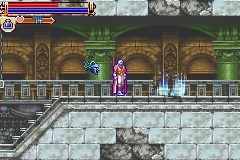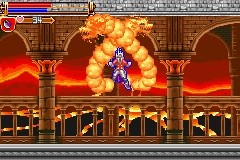|
|

|
BATTLE SYSTEM
|

|
INTERACTION
|

|
ORIGINALITY
|

|
STORY
|

|
MUSIC & SOUND
|

|
VISUALS
|

|
CHALLENGE
|
Low
|
COMPLETION TIME
|
10-20 hours
|
|
OVERALL
3.0/5
|
Rating definitions
|
|
|
Castlevania titles in recent years have been nothing but goodness, or so it would seem. Even the 3D titles on PS2 have been of generally high quality. Coming prior to the triumphs of Castlevania: Aria of Sorrow and post the triumph that is Castlevania: Circle of the Moon, one would presume Castlevania: Harmony of Dissonance to be another in the string of high quality. According to some, this is indeed the case. Harmony of Dissonance suffers from a few ailments however, and while the Konami development team is too skilled to allow these ailments to be fatal, the result is one unfortunately diseased patient.
Story is never an integral component of a Castlevania title, and Harmony of Dissonance is not the exception to prove the rule. The player assumes control of Juste Belmont, another in the storied line of vampire slayers. Juste ends up in Dracula’s castle and must find a way out, which seems to be via confronting the master of the house. He is in there with a few others however, and it confuses the seemingly simple thrust of the situation – a little. Story-intensive gamers will be very disappointed.
 Playing hard-to-get with a Medusa Head? Juste has been alone too long.
Playing hard-to-get with a Medusa Head? Juste has been alone too long.
|
|
Seekers of challenges aplenty are also not encouraged to take up this title. While Harmony of Dissonance is not completely lacking in challenge, anyone accustomed to standard Castlevania difficulty will be flabbergasted at how much easier this title is. Enemies lack the power to kill Juste quickly and efficiently, depending upon numbers to do the job – and numbers are frequently not present either. Concurrently, replay is extant but not great. RPGamers without any action gaming skills will still experience problems, however. There is more than one ending to achieve with Juste, and another character to play as – though Maxim has no dialogue and is just there to give a different playing style to the player. The additional endings depend upon one’s actions during the final sequence of events, and may not add up to much additional playing time.
The visuals are near the pinnacle of GBA abilities, but not quite. Enemies do pull off some very impressive-looking attacks and forms, with spells (more on that later) looking pretty snazzy as well. Aria of Sorrow would do this a bit better though, so Harmony of Dissonance’s visuals cannot quite be judged at the top of GBA titles. Aurally, on the other hand, Harmony of Dissonance puts in a shabby effort. The music itself is okay but not great, while its quality is outshined by the audio in a few NES titles. Yes, this music is distinctly 8-bit in sound quality, and that is not acceptable for a GBA title.
The most important part of a Castlevania title is its actual play experience, and for the most part Harmony of Dissonance achieves the Castlevania feel: although the lack of difficulty impacts negatively here. Juste controls in a fashion quite reminiscent of Alucard and Nathan Graves; his whip responds to the call for Dracula’s servants to be smote. Exploration proceeds in the Metroid-influenced way pioneered by Castlevania: Symphony of the Night, with new areas being accessible after new abilities are acquired. Experience is once again acquired through slaying Dracula’s minions, and money is present here as it was not in Circle of the Moon. Sub-weapons are again present, and it is through the sub-weapons that magic is used. In tandem with one of six magical books to be located throughout the game, each of the five sub-weapons becomes a magic spell of enemy destruction. Though each of these spells looks different, there isn’t much variety between them. Controls, as one would expect in a Castlevania title, are tight.
 Flaming dragons – from Konami? Call Capcom’s legal department!
Flaming dragons – from Konami? Call Capcom’s legal department!
|
|
Menu interfaces are functional and tidy also. Generally the player will want to access the map frequently, and this is quick to accomplish. Using items and switching spell books is also accomplished quickly and easily. Menus will not impede the prospective player’s quest to finish off this title in good time, although true completion of the game will require nearly twice what the initial completion time seems to be. While Harmony of Dissonance will probably require longer to complete than Circle of the Moon, it lacks the multiple replay experiences to be found in the prior title, and thus total time spent with HoD will suffer.
In the annals of Castlevania action-RPG titles, Harmony of Dissonance is unfortunately the least. It is hardly terrible, but it lacks an outstanding feature in the vein of earlier and later titles to differentiate it from the others. Aria of Sorrow would introduce a storyline that still (as of late 2006) persists in Castlevanias, while Symphony of the Night pioneered this sub-genre and Circle of the Moon exemplified handheld gaming depth. Harmony of Dissonance does not bring anything so emblematic to the table, and suffers as a result. Even without its own minuses, the absence of a massive ‘plus’ makes for a Castlevania experience that is sadly less than stellar.
Review Archives
|









